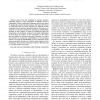RTAS
2007
IEEE
14 years 12 months ago
2007
IEEE
Most of today’s real-time embedded systems consist of a heterogeneous mix of fully-programmable processors, fixed-function components or hardware accelerators, and partially-pr...
IPPS
2007
IEEE
14 years 12 months ago
2007
IEEE
In this paper we present a software tool for the simulation of distributed real-time embedded systems. Our tool is based on the popular NS-2 package for simulating the networking ...
ICST
2008
IEEE
15 years 2 days ago
2008
IEEE
Real-time embedded systems typically include concurrent tasks of different priorities with time-dependent operations accessing common resources. In this context, unsynchronized pa...
FGCN
2008
IEEE
15 years 4 days ago
2008
IEEE
Dynamic frequency scaling (DFS) techniques for real-time embedded systems have been widely studied. However, most of the scheduling algorithms so far concern only special purpose ...
COMPSAC
2008
IEEE
15 years 4 days ago
2008
IEEE
The conflicting requirements of real-time embedded systems, e.g. minimizing memory usage while still ensuring that all deadlines are met at run-time, require rigorous analysis of...
ISORC
2009
IEEE
15 years 9 days ago
2009
IEEE
Complex real-time embedded systems should be compositional and deterministic in the resource, time, and value domains. Determinism eases the engineering of correct systems and com...
RTSS
2009
IEEE
15 years 12 days ago
2009
IEEE
Real-time embedded systems are increasingly being built using commercial-off-the-shelf (COTS) components such as mass-produced peripherals and buses to reduce costs, timeto-market...
RTCSA
2009
IEEE
15 years 12 days ago
2009
IEEE
Distributed real-time embedded systems have stringent requirements for key performance properties, such as endto-end timeliness and reliability, in order to operate properly. In r...
DATE
2009
IEEE
15 years 13 days ago
2009
IEEE
—In this paper we propose a UML/MDA approach, called MoPCoM methodology, to design high quality real-time embedded systems. We have defined a set of rules to build UML models fo...
ECBS
2010
IEEE
15 years 17 days ago
2010
IEEE
—One of the key challenges in modern real-time embedded systems is safe composition of different software components. Formal verification techniques provide the means for design...






